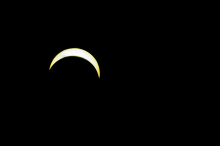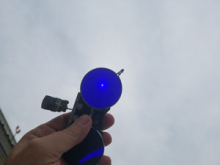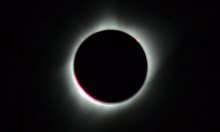Total solar eclipse brought moments of summer wonder to University Hospital

August 21, 2017 brought solar eclipse fever to millions of people in the United States caught up in the excitement of witnessing the event - and UW-Madison was no exception. On the day of the eclipse, a crowd gathered at the rooftop garden at University Hospital.
 With protective solar glasses and pinhole projectors in hand - and passed around to share - dozens of physicians, nurses, and staff members paused briefly to gaze with wonder at the total solar eclipse, which reached a maximum of 85 percent in Madison, Wisconsin. It was the first time in nearly 100 years that a total solar eclipse followed a coast-to-coast path across the middle of the United States.
With protective solar glasses and pinhole projectors in hand - and passed around to share - dozens of physicians, nurses, and staff members paused briefly to gaze with wonder at the total solar eclipse, which reached a maximum of 85 percent in Madison, Wisconsin. It was the first time in nearly 100 years that a total solar eclipse followed a coast-to-coast path across the middle of the United States.
By 1:15 PM, clouds had dispelled just enough for onlookers to be able to don glasses and view the phenomenon. Reactions included audible gasps, grins, and attempts to photograph the moon-blocked sun with cell phones equipped with filters.
Department of Medicine photographer Clint Thayer captured an image, and scientists across campus at the UW-Madison Space Science and Engineering Center gathered time-lapse images captured by one of the world's most advanced weather satellites, GOES-16. The team stitched satellite images together to create a video showing the shadow of the moon tracking across the continental United states.
Scientists at UW–Madison’s Space Science and Engineering Center (SSEC) observed the eclipse through the eye of one of the world’s most advanced weather satellites, GOES-16. The images were taken at a rate of one every five minutes. Stitched together, they show the shadow of the moon tracking west to east across the continental United States.
"Seeing everyone gather in awe was just a wonderful moment," said Richard Page, MD, George R. and Elaine Love Professor and chair, Department of Medicine.
Even the UW Health Med Flight team had a chance to enjoy the eclipse. "Fortunately, or unfortunately, the sun only had 87 percent peak coverage out at Mineral Point, Wisconsin Med Flight base.  This still gave us light similar to early evening so there were no changes to any of our operations," said Michael Abernethy, MD, clinical professor, Department of Emergency Medicine and flight physician, UW Health Med Flight. "We had pretty heavy overcast but were still able to view some of the eclipse using a pair of welders' glasses," he said (shown at right).
This still gave us light similar to early evening so there were no changes to any of our operations," said Michael Abernethy, MD, clinical professor, Department of Emergency Medicine and flight physician, UW Health Med Flight. "We had pretty heavy overcast but were still able to view some of the eclipse using a pair of welders' glasses," he said (shown at right).
 A family trip to Wyoming allowed a different perspective of the eclipse for Ryan Mattison, MD, associate professor (CHS), Hematology, Medical Oncology and Palliative Care. "I took photos of the eclipse from Riverton, Wyoming and also snapped a picture of my wife, Amy, viewing the partial phase through a filtered telescope," said Dr. Mattison (shown below). The pair stopped to view the phenomenon during a trip to Yellowstone and Grand Teton National Parks.
A family trip to Wyoming allowed a different perspective of the eclipse for Ryan Mattison, MD, associate professor (CHS), Hematology, Medical Oncology and Palliative Care. "I took photos of the eclipse from Riverton, Wyoming and also snapped a picture of my wife, Amy, viewing the partial phase through a filtered telescope," said Dr. Mattison (shown below). The pair stopped to view the phenomenon during a trip to Yellowstone and Grand Teton National Parks.
Resources:
- "The solar eclipse over UW-Madison," UW News, August 21, 2017